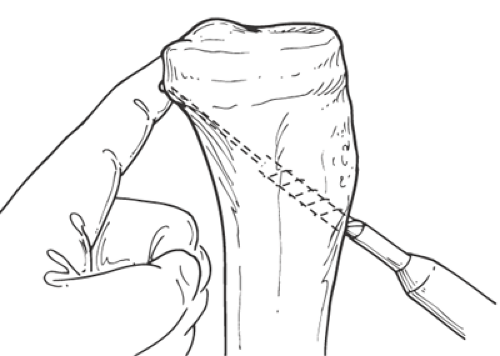Arthroscopic Posterior Cruciate Ligament Reconstruction: Transtibial Tunnel Technique
Gregory C. Fanelli MD
The incidence of posterior cruciate ligament (PCL) injuries is reported to be from 1% to 40% of acute knee injuries. This range is dependent upon the patient population reported and is approximately 3% in the general population and 38% in reports from regional trauma centers.1,2,3 Our practice at a regional trauma center has a 38.3% incidence of PCL tears in acute knee injuries, and 56.5% of these PCL injuries occur in multiple trauma patients. Of these PCL injuries 45.9% are combined ACL/PCL tears, while 41.2% are PCL/posterolateral corner tears. Only 3% of acute PCL injuries seen in the trauma center are isolated.
This chapter illustrates my surgical technique of the arthroscopic single bundle/single femoral tunnel transtibial (SB/SFT TTT) PCL reconstruction surgical procedure and presents the Fanelli Sports Injury Clinic 2- to 10-year results of PCL reconstruction using this surgical technique. The information presented in this chapter has also been presented elsewhere, and the reader is referred to these sources for additional information regarding this topic.4,5,6,7,8,9,10,11,12,13,14,15,16,17,18,19
Surgical Indications
The SB/SFT TTT PCL reconstruction is an anatomic reconstruction of the anterolateral bundle of the PCL. The anterolateral bundle tightens in flexion, and this reconstruction reproduces that biomechanical function. While the SB/SFT TTT PCL reconstruction does not reproduce the broad anatomic insertion site of the normal PCL, there are certain factors that lead to success with this surgical technique:
Identify and treat all pathology (especially posterolateral instability).
Accurate tunnel placement.
Anatomic graft insertion sites.
Strong graft material.
Minimize graft bending.
Final tensioning at 70 degrees to 90 degrees of knee flexion.
Graft tensioning.
a Arthrotek mechanical tensioning device.
Primary and back-up fixation.
Appropriate rehabilitation program.
Surgical Indications
Our indications for surgical treatment of acute PCL injuries include insertion site avulsions, tibial step off decreased 10 mm or greater, and PCL tears combined with other structural injuries. Our indications for surgical treatment of chronic PCL injuries are when an isolated PCL tear becomes symptomatic, or when progressive functional instability develops.
Surgical Technique
Patient Positioning and Initial Set Up
The patient is positioned on the operating table in the supine position, and the surgical and nonsurgical knees are examined under general anesthesia. A tourniquet is applied to the operative extremity, and the surgical leg prepped and draped in a sterile fashion. Allograft tissue is prepared prior to beginning the surgical procedure, and autograft tissue is harvested prior to beginning the arthroscopic portion of the procedure. The arthroscopic instruments are inserted with the inflow through the superior lateral patellar portal, the arthroscope in the inferior lateral patellar portal, and the instruments in the inferior medial patellar portal. The portals are interchanged as necessary. The joint is thoroughly
evaluated arthroscopically, and the PCL evaluated using the three-zone arthroscopic technique.5 The PCL tear is identified, and the residual stump of the PCL is debrided with hand tools and the synovial shaver.
evaluated arthroscopically, and the PCL evaluated using the three-zone arthroscopic technique.5 The PCL tear is identified, and the residual stump of the PCL is debrided with hand tools and the synovial shaver.
Initial Incision
An extra capsular posteromedial safety incision approximately 1.5 to 2.0 cm long is created (Fig. 45-1). The crural fascia is incised longitudinally, taking precautions to protect the neurovascular structures. The interval is developed between the medial head of the gastrocnemius muscle and the posterior capsule of the knee joint, which is anterior. The surgeon’s gloved finger is able to have the neurovascular structures posterior to the finger, and the posterior aspect of the joint capsule anterior to the surgeon’s finger. This technique enables the surgeon to monitor surgical instruments such as the over-the-top PCL instruments and the PCL and anterior cruciate ligament (ACL) drill guides as they are positioned in the posterior aspect of the knee. The surgeon’s finger in the posteromedial safety incision also confirms accurate placement of the guide wire prior to tibial tunnel drilling in the medial-lateral and proximal-distal directions (Fig. 45-2).
Elevating the Posterior Capsule
The curved over-the-top PCL instruments are used to carefully lyse adhesions in the posterior aspect of the knee and to elevate the posterior knee joint capsule away from the tibial ridge on the posterior aspect of the tibia. This capsular elevation enhances correct drill guide and tibial tunnel placement (Fig. 45-3).
 Fig. 45-1. Posteromedial extra-articular extracapsular safety incision. (Adapted with permission from Arthrotek, Inc., Warsaw, Ind.) |
Drill Guide Positioning
The arm of the Arthrotek Fanelli PCL-ACL Drill Guide is inserted into the knee through the inferior medial patellar portal and positioned in the PCL fossa on the posterior tibia (Fig. 45-4). The bullet portion of the drill guide contacts the anterior medial aspect of the proximal tibia approximately 1 cm below the tibial tubercle, at a point midway between the tibial crest anteriorly and the posterior medial border of the tibia. This drill guide positioning creates a tibial tunnel that is relatively vertically oriented and has its posterior
exit point in the inferior and lateral aspects of the PCL tibial anatomic insertion site. This positioning creates an angle of graft orientation such that the graft will turn two very smooth 45-degree angles on the posterior aspect of the tibia, eliminating the “killer turn” of 90-degree graft angle bending (Fig. 45-5).
exit point in the inferior and lateral aspects of the PCL tibial anatomic insertion site. This positioning creates an angle of graft orientation such that the graft will turn two very smooth 45-degree angles on the posterior aspect of the tibia, eliminating the “killer turn” of 90-degree graft angle bending (Fig. 45-5).
Stay updated, free articles. Join our Telegram channel

Full access? Get Clinical Tree









